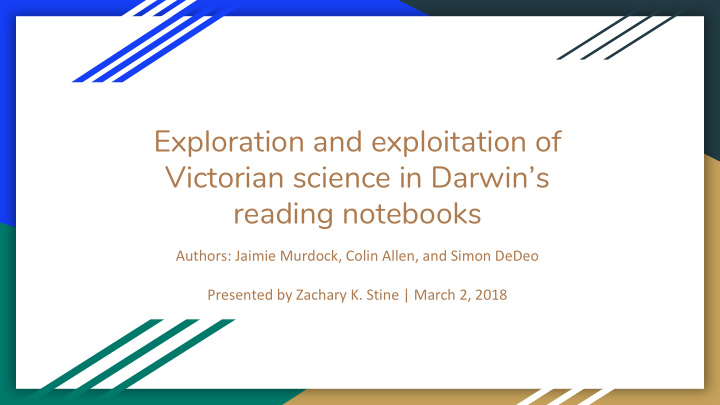



Exploration and exploitation of Victorian science in Darwin’s reading notebooks Authors: Jaimie Murdock, Colin Allen, and Simon DeDeo Presented by Zachary K. Stine | March 2, 2018
I. Introduction
Information-foraging strategies ● Exploitation -- researching in domains in which an individual is an expert. ● Exploration -- researching in domains that are novel to an individual. ● Cognitive searching requires some balance of exploiting existing resources while also exploring new resources.
Charles Darwin (1809-1882) ● Case study of an individual’s information-foraging strategies ● A qualitatively well-studied individual ● Left reading lists during some of the most productive years of his life source: Wikipedia
II. Materials and Methods
Data ● Full text of 665 (out of 687) English non-fiction books read by Darwin ● Covers 23 years (1837 - 1860)
Probabilistic topic document models (LDA) words ● Each document represented as a bag of words generated by a mixture of “topics” ● Have to choose the number of topics, k ● Lets us think of a document as a ... topic 1 topic 2 topic 3 topic k distribution over the k topics
Cognitive surprise: Kullback-Leibler divergence ● Given what one has already read, how much are we surprised by the next book read? ● KL divergence: given a distribution, p , how much surprise is in distribution, q ? ○ p ← distribution of topics already observed ○ q ← distribution of topics in the next book ● Two versions ○ Text-to-text surprise (T2T) ■ p is the distribution of topics in the last book read only ■ Local surprise ○ Text-to-past surprise (T2P) ■ p is the distribution of topics in all books previously read ■ Global surprise
Cultural production and null reading models Cultural production Null model ● ● Uses the same texts Permutations of possible reading orders ● ● Ordered by publication date Gives us an idea of average, expected surprise ● I.e., the order that the broader culture ● produced them All results are relative to this null model ● How does Darwin’s foraging compare with foraging of culture?
Bayesian epoch estimation (BEE) ● Unsupervised approach for identifying sustained periods of exploitation or exploration ● Each epoch is defined by ○ A beginning point (either beginning of data or the end of the previous epoch) ○ An average level of surprise ○ The variance around that average ● Requires n number of epochs to be chosen ○ For larger n , better fit but likely to cause overfitting ○ Akaike Information Criterion (AIC) used to constrain n ● Minimum epoch length restricted to 5 years ● Will these information-foraging epochs align with salient events in Darwin’s life?
III. Results
Exploration and exploitation ● Darwin is more exploitative than the null model for both T2T and T2P ● Compared with a greedy path that minimizes surprise through documents: ○ Darwin is much more exploratory in T2T ○ But surprisingly less exploratory in T2P
Readings over time ● Negative slope means less surprise than null model (exploitation) ● Positive slope means more surprise than null model (exploration) ● Three epochs shown by white and grey bands inferred using BEE
Individual and collective ● Both T2T and T2P surprise is greater in the ordering of texts as Darwin read them compared with the order they were produced ● Darwin is sampling texts in a way that juxtaposes their themes to a greater degree than the population producing them
Strategy shifts between biographically significant epochs Major events in Darwin’s life during this time (qualitatively identified): ● 2 October 1836 - 30 September 1846 ○ beginning of data - last volumes from HMS Beagle studies published ○ T2T and T2P: exploitation ● 1 October 1846 - 8 September 1854 ○ start of work on barnacles - last volume of barnacles work published ○ T2T: exploitation, T2P: exploration ● 9 September 1854 - 1860 ○ start notes on species - Origin of Species and end of data ○ T2T and T2P: exploration
Unsupervised detection of strategy shifts Without knowing the dates of the qualitatively important events, inferred epochs that align very closely with those events: ● Start of the first epoch does not need to be inferred (just the beginning of the data): 2 October 1836 ● Start of the second epoch: 27 May 1846 ● Start of the third epoch: 16 September 1854
Qualitative vs. quantitative epoch dates Qualitative epochs: Quantitative epochs:
Qualitative vs. quantitative epoch dates Qualitative epochs: ~4 months apart Quantitative epochs: 1 week apart
IV. Discussion
Discussion ● Many studies exist that focus solely on population-level cultural change ● Understanding mechanisms behind population-level changes requires understanding cognitive processes at individual-level as well ● Extending beyond Darwin, can look at reading records of others ○ UK Reading Experience Database (1450-1945) ○ 50 million users on Goodreads
Questions?
Link to paper on journal’s website: https://www.sciencedirect.com/science/article/pii/S0010027716302840 Link to paper on arXiv: https://arxiv.org/pdf/1509.07175.pdf
Recommend
More recommend